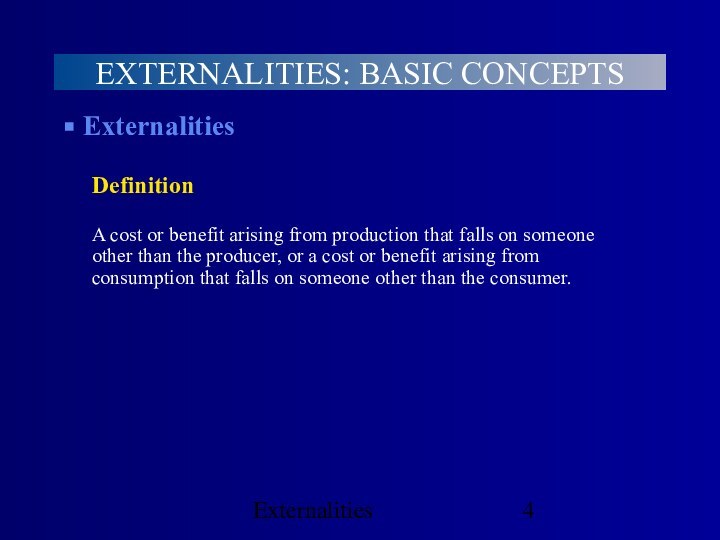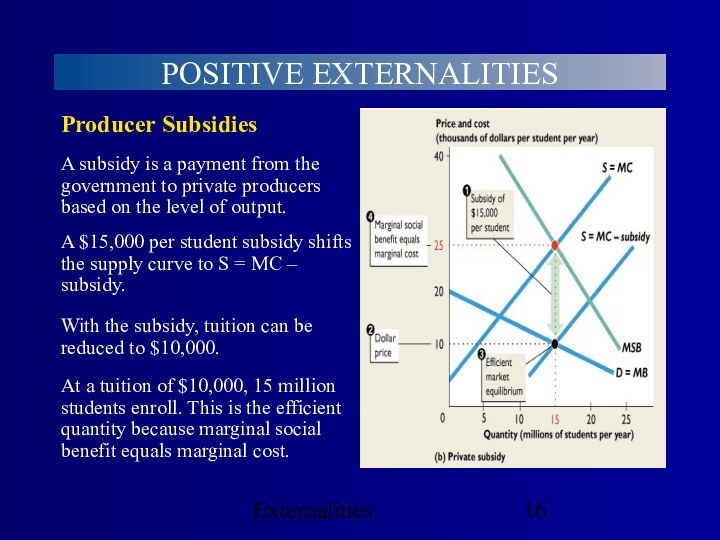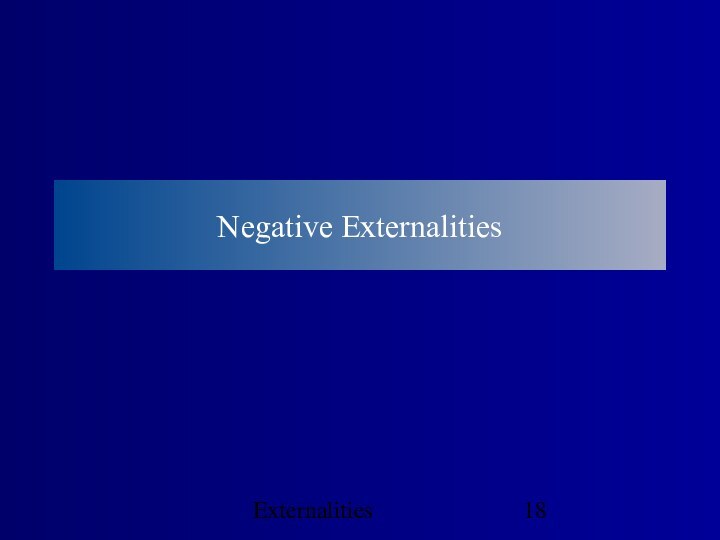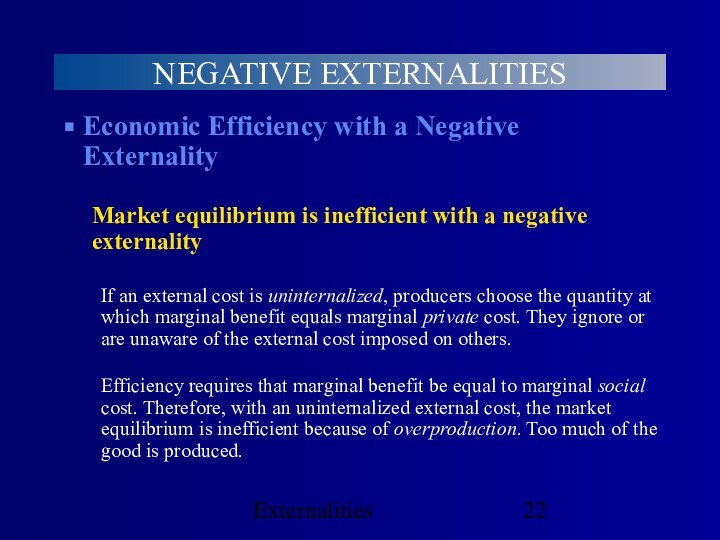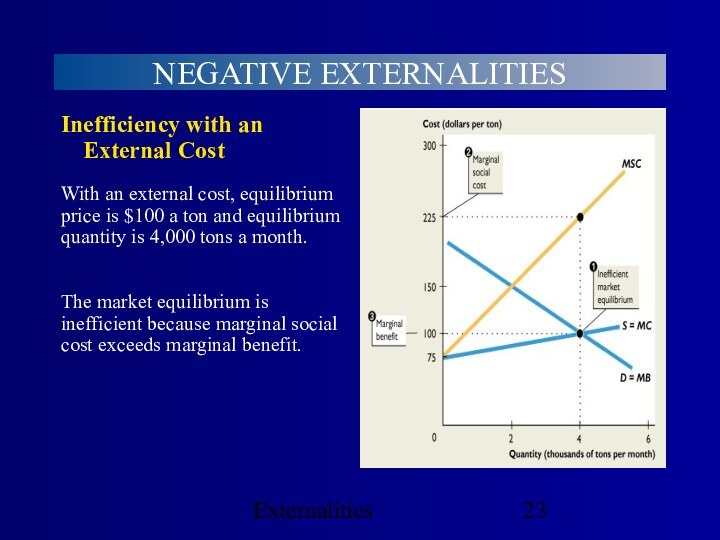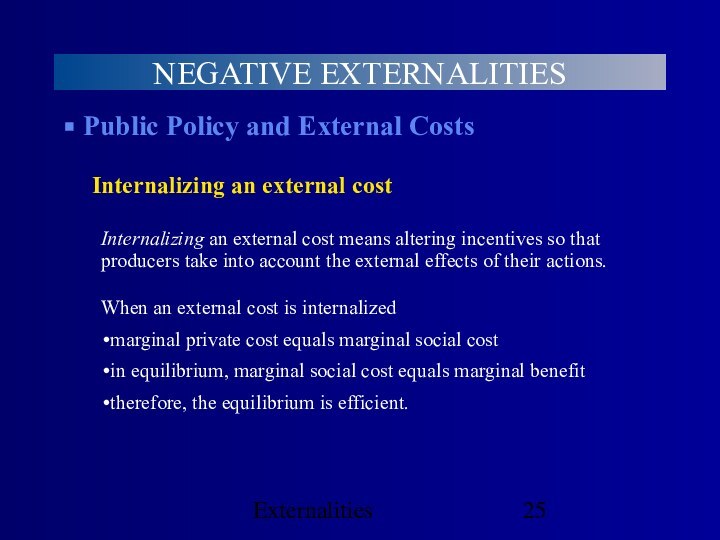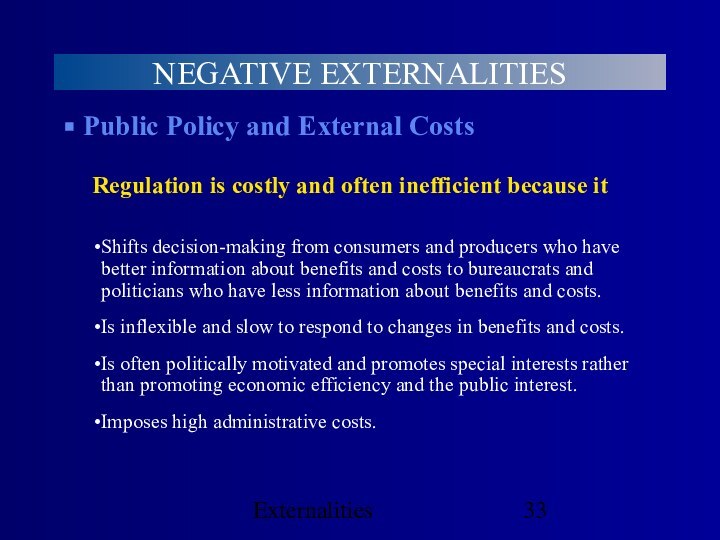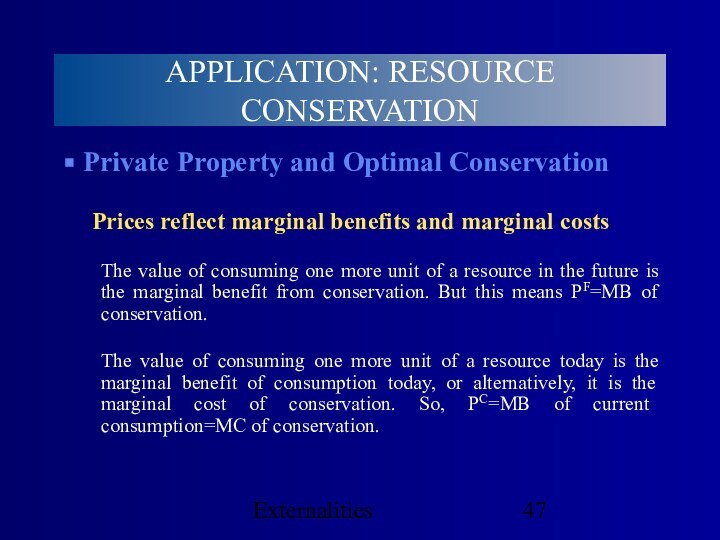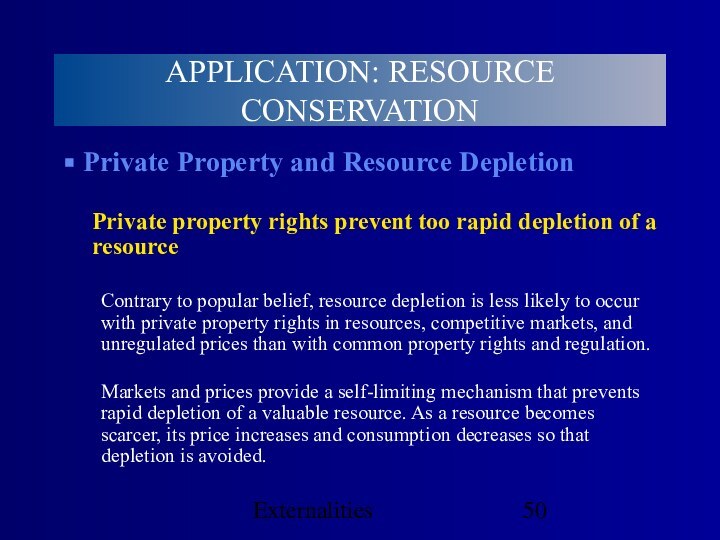Слайд 2
Externalities
TOPIC OUTLINE
Externalities: Basic Concepts
Positive Externalities
Inefficiency with a Positive
Externality
Public Policy to Improve Efficiency
Negative Externalities
Inefficiency with a Negative
Externality
Public Policy to Improve Efficiency
Application: Resource Conservation
Слайд 3
Externalities
Externalities: Basic Concepts
Слайд 4
Externalities
Externalities
Definition
A cost or benefit arising from production that
falls on someone other than the producer, or a
cost or benefit arising from consumption that falls on someone other than the consumer.
EXTERNALITIES: BASIC CONCEPTS
Слайд 5
Externalities
Externalities
Positive externality or external benefit
A production or consumption
activity that creates an external benefit.
Negative externality or external
cost
A production or consumption activity that creates an external cost.
EXTERNALITIES: BASIC CONCEPTS
Слайд 6
Externalities
Positive Externalities
Слайд 7
Externalities
POSITIVE EXTERNALITIES
Private Benefits and Social Benefits
Marginal private benefit
The
benefit to the consumer of an additional unit of
a good or service.
Marginal external benefit
The benefit of an additional unit of a good or service that people other than the consumer of the good or service enjoy.
Слайд 8
Externalities
POSITIVE EXTERNALITIES
Private Benefits and Social Benefits
Marginal social benefit
The
marginal benefit enjoyed by the entire society—by the consumers
of a good or service and by everyone else who benefits from it.
Marginal social benefit is the sum of marginal private benefit and marginal external benefit:
MSB = MB + Marginal external benefit
Слайд 9
Externalities
POSITIVE EXTERNALITIES
When 15 million students
attend college . .
.
marginal external benefit is $15,000 per student.
marginal private benefit
is $10,000 per student.
marginal social benefit is $25,000 per student.
Private Benefit and Social Benefit with an Externality
An external benefit creates a wedge between social benefit and private benefit.
Слайд 10
Externalities
POSITIVE EXTERNALITIES
Economic Efficiency with a Positive Externality
Market equilibrium
is inefficient with a positive externality
If an external benefit
is uninternalized, consumers choose the quantity at which marginal private benefit equals marginal cost. They ignore or are unaware of the external benefit received by others.
Efficiency requires that marginal social benefit be equal to marginal cost. Therefore, with an uninternalized external benefit, the market equilibrium is inefficient because of underproduction. There is too little of the good.
Слайд 11
Externalities
POSITIVE EXTERNALITIES
Inefficiency with an External Benefit
With an external
benefit, equilibrium tuition is $15,000 and the equilibrium quantity
is 7.5 million students.
The market equilibrium is inefficient because marginal social benefit exceeds marginal cost. In other words, people other than the students benefit from the students’ education and would be willing to pay something for it.
Слайд 12
Externalities
POSITIVE EXTERNALITIES
The gray triangle shows the deadweight loss
created by the uninternalized external benefits of college education.
The
efficient quantity is 15 million students, where marginal social benefit equals marginal cost.
Inefficiency with an External Benefit
Слайд 13
Externalities
POSITIVE EXTERNALITIES
Public Policy and External Benefits
Internalizing an external
benefit
Internalizing an external benefit means altering incentives so that
consumers take into account the external effects of their actions.
When an external benefit is internalized
marginal private benefit equals marginal social benefit
in equilibrium, marginal social benefit equals marginal cost
therefore, the equilibrium is efficient.
Слайд 14
Externalities
POSITIVE EXTERNALITIES
Public Policy and External Benefits
Education is an
example of a positive externality
We use education to illustrate
public policy actions for internalizing an external benefit.
The external benefits from education can be internalized by
Public provision
Producer subsidies
Vouchers (consumer subsidies)
Слайд 15
Externalities
POSITIVE EXTERNALITIES
Public Provision
To provide incentives for the efficient
number of students to enroll, the agency sets tuition
equal to marginal private benefit at the efficient quantity.
Tuition is $10,000. Tax revenues cover the remaining $15,000 of marginal cost per student.
With public provision, a tax-funded public agency produces education.
The efficient quantity is 15 million students where marginal social benefit equals marginal cost.
Слайд 16
Externalities
POSITIVE EXTERNALITIES
At a tuition of $10,000, 15 million
students enroll. This is the efficient quantity because marginal
social benefit equals marginal cost.
A $15,000 per student subsidy shifts the supply curve to S = MC – subsidy.
With the subsidy, tuition can be reduced to $10,000.
Producer Subsidies
A subsidy is a payment from the government to private producers based on the level of output.
Слайд 17
Externalities
POSITIVE EXTERNALITIES
Buyers pay their marginal benefit of $10,000
and the voucher pays the difference.
With the voucher, 15
million students are willing to pay $25,000 per student. The equilibrium is efficient because marginal social benefit equals marginal cost.
Vouchers
A $15,000 voucher shifts the demand curve up to equal the marginal social benefit.
A voucher is a subsidy to consumers for the purchase of specified goods or services.
Слайд 18
Externalities
Negative Externalities
Слайд 19
Externalities
NEGATIVE EXTERNALITIES
Private Costs and Social Costs
Marginal private cost
The
cost of producing an additional unit of a good
or service that is borne by the producer of that good or service.
Marginal external cost
The cost of producing an additional unit of a good or service that falls on people other than the producer.
Слайд 20
Externalities
NEGATIVE EXTERNALITIES
Private Costs and Social Costs
Marginal social cost
The
marginal cost incurred by the entire society—by the producer
and by everyone else on whom the cost falls.
Marginal social cost is the sum of marginal private cost and marginal external cost:
MSC = MC + Marginal external cost
Слайд 21
Externalities
NEGATIVE EXTERNALITIES
Private Cost and Social Cost with an
Externality
When output is 4,000 tons of chemicals per month
. . .
marginal private cost is $100 a ton.
marginal external cost is $125 a ton.
marginal social cost is $225 a ton.
An external cost creates a wedge between social cost and private cost.
Слайд 22
Externalities
NEGATIVE EXTERNALITIES
Economic Efficiency with a Negative Externality
Market equilibrium
is inefficient with a negative externality
If an external cost
is uninternalized, producers choose the quantity at which marginal benefit equals marginal private cost. They ignore or are unaware of the external cost imposed on others.
Efficiency requires that marginal benefit be equal to marginal social cost. Therefore, with an uninternalized external cost, the market equilibrium is inefficient because of overproduction. Too much of the good is produced.
Слайд 23
Externalities
NEGATIVE EXTERNALITIES
With an external cost, equilibrium price is
$100 a ton and equilibrium quantity is 4,000 tons
a month.
Inefficiency with an External Cost
The market equilibrium is inefficient because marginal social cost exceeds marginal benefit.
Слайд 24
Externalities
NEGATIVE EXTERNALITIES
The gray triangle shows the dead-weight loss
created by the uninternalized pollution externality.
Inefficiency with an External
Cost
The efficient quantity is 2,000 tons a month, where marginal social cost equals marginal benefit.
Слайд 25
Externalities
NEGATIVE EXTERNALITIES
Public Policy and External Costs
Internalizing an external
cost
Internalizing an external cost means altering incentives so that
producers take into account the external effects of their actions.
When an external cost is internalized
marginal private cost equals marginal social cost
in equilibrium, marginal social cost equals marginal benefit
therefore, the equilibrium is efficient.
Слайд 26
Externalities
NEGATIVE EXTERNALITIES
Public Policy and External Costs
Pollution is an
example of a negative externality
We use pollution to illustrate
public policy actions for improving economic efficiency when there are external costs.
Zero pollution is not an option. Pollution imposes costs on society, but the production activities that generate pollution also confer benefits.
The objective is to balance the costs of pollution against the benefits from the goods and services whose production generates pollution—in other words, to find the optimal or efficient amount of pollution.
Слайд 27
Externalities
NEGATIVE EXTERNALITIES
The efficient quantity is 2,000 tons a
month where MB=MSC. When production is efficient, the amount
of pollution is optimal.
Optimal (Economically Efficient) Pollution
The equilibrium quantity is 4,000 tons a month where MB=MC.
The equilibrium is inefficient because marginal social cost exceeds marginal benefit. At the equilibrium, there is too much production and too much pollution.
Слайд 28
Externalities
NEGATIVE EXTERNALITIES
Public Policy and External Costs
Quasi-market policies to
achieve optimal pollution
Economists favor quasi-market approaches that rely on
incentives to improve efficiency when there is pollution.
Quasi-market approaches to reducing pollution include
Marketable permits (or tradable emission rights)
Emission charges
Pollution taxes
Слайд 29
Externalities
NEGATIVE EXTERNALITIES
Public Policy and External Costs
Marketable permits
The optimal
amount of pollution in a geographic area is determined
based on marginal benefits and marginal costs. Each polluter is assigned a pro rata share of the total allowed pollution.
Polluters are allowed to buy and sell their pollution permits. In this way, a market is created in pollution rights and the market establishes prices for the right to pollute.
Polluters who can reduce pollution at relatively low cost sell their permits to polluters for whom pollution reduction would be relatively more costly.
Слайд 30
Externalities
NEGATIVE EXTERNALITIES
Public Policy and External Costs
Emission charges
A price
charged to polluters per unit of pollution. Emission charges
have effects similar effects to pollution taxes.
Pollution taxes
A tax imposed on polluters equal to the marginal external cost of the polluting activity.
Слайд 31
Externalities
NEGATIVE EXTERNALITIES
Equilibrium price with the tax is $150
a ton and equilibrium quantity is 2,000 tons a
month.
The market equilibrium with the tax is efficient because marginal social cost equals marginal benefit.
Effects of a Pollution Tax
A pollution tax equal to the marginal external cost of pollution is imposed.
Marginal private cost with the tax equals marginal social cost.
Слайд 32
Externalities
NEGATIVE EXTERNALITIES
Public Policy and External Costs
Advantages of quasi-market
policies
Quasi-market policies are more efficient than regulation in promoting
economic efficiency and achieving optimal pollution.
The desired amount of pollution reduction is achieved at the lowest possible cost.
Because pollution rights have a price, polluters have incentives to substitute less-polluting technologies for existing technologies or to develop new less-polluting technologies.
Слайд 33
Externalities
NEGATIVE EXTERNALITIES
Public Policy and External Costs
Regulation is costly
and often inefficient because it
Shifts decision-making from consumers and
producers who have better information about benefits and costs to bureaucrats and politicians who have less information about benefits and costs.
Is inflexible and slow to respond to changes in benefits and costs.
Is often politically motivated and promotes special interests rather than promoting economic efficiency and the public interest.
Imposes high administrative costs.
Слайд 34
Externalities
NEGATIVE EXTERNALITIES
Private Action to Internalize an Externality
Private action
is an alternative to public policy
Many externalities are internalized
by private action—by private negotiation among the affected individuals, by adjustment of market prices, and by rearrangement of property rights. No public policy action is necessary to internalize these externalities.
If only a small number of individuals are involved and transaction costs are low, then private negotiation among the affected individuals can internalize an externality.
With complete and efficient markets, market prices may internalize externalities, increasing to reflect the value of an external benefit or decreasing to reflect an external cost.
Слайд 35
Externalities
Final Observation
Not every externality problem is worth solving
An
uninternalized externality imposes an opportunity cost on society. The
opportunity cost is the deadweight loss that arises from overproduction with a negative externality or underproduction with a positive externality.
But, there are also costs to internalizing an externality. Sometimes the costs of internalizing the externality are greater than the cost of the externality. In that case, the optimal action is no action—do nothing. Internalizing the externality costs more than it is worth.
NEGATIVE EXTERNALITIES
NEGATIVE EXTERNALITIES
Слайд 36
Externalities
Application: Resource Conservation
Слайд 37
Externalities
Property Rights and Conservation
Private property encourages optimal conservation
Many
people mistakenly believe that resources are more likely to
be conserved for the future and less likely to be depleted if they are owned in common than if they are private property.
In fact, quite the opposite is true. Unlike common property rights, private property rights
provide incentives for optimal conservation of a resource and
ensure against too rapid depletion of a resource.
APPLICATION: RESOURCE CONSERVATION
Слайд 38
Externalities
Common Property Resources
Definition
A resource for which rights are
held in common by a group of individuals none
of whom has exclusive ownership. With common property resources, property rights are absent or incomplete.
Typically, the only right to a common property resource that an individual possesses is the right to current use of the resource. In particular, an individual has no guaranteed future interest in the resource.
APPLICATION: RESOURCE CONSERVATION
Слайд 39
Externalities
Common Property Resources
Common property rights create uninternalized externalities
An
individual who refrains from consuming a resource now and
conserves it for the future incurs a cost. The cost is the loss in value the individual would obtain from current consumption. But the individual also creates a benefit by increasing the amount of the resource available for future consumption.
APPLICATION: RESOURCE CONSERVATION
Слайд 40
Externalities
Common Property Resources
With common property rights, the benefits
from future consumption may be enjoyed by all of
society. Thus, conservation generates external benefits so there is too little conservation and too much current consumption.
Because of the absence of private property rights, especially the lack of a guaranteed future interest, common property resources tend to be overused, poorly maintained, and depleted too rapidly.
APPLICATION: RESOURCE CONSERVATION
Слайд 41
Externalities
APPLICATION: RESOURCE CONSERVATION
Externalities and Property Rights
Externalities arise when
private property rights are absent or unenforced
Private property rights
provide incentives for individuals to use resources efficiently and prevent individuals from imposing costs on others without compensation.
Externalities arise when private property rights are either absent or unenforced.
By establishing private property rights and enforcing existing rights, some externalities can be internalized.
Слайд 42
Externalities
Externalities and Property Rights
Example: Property rights and pollution
Suppose
polluting factories own a river and the homes along
it. The more the factories pollute, the less rent are people willing to pay to live in the homes.
Suppose the residents own the river and the homes. Then, the factories must pay the homeowners for polluting the river. The more the factories pollute, the more they pay.
APPLICATION: RESOURCE CONSERVATION
Слайд 43
Externalities
Externalities and Property Rights
Either way, regardless of who
owns the river, so long as someone owns it,
the factories bear the cost of polluting the river, the quantity of the goods produced is efficient, and the amount of pollution is optimal.
But if there are no enforced property rights, if neither the factories nor the residents own the river, the factory can pollute the river without bearing any cost. The costs of the pollution fall on the residents, and there is overproduction and too much pollution.
APPLICATION: RESOURCE CONSERVATION
Слайд 44
Externalities
Efficiency with Private Property Rights
With complete and enforced
private property rights, the producer’s supply curve is the
MC curve that includes the cost of pollution—the marginal social cost curve.
If private property rights are absent or unenforced, the producer pays only the marginal private cost. The producer’s supply curve is the MC curve that excludes pollution costs.
APPLICATION: RESOURCE CONSERVATION
Слайд 45
Externalities
Efficiency with Private Property Rights
Equilibrium price is $150
a ton and equilibrium quantity is 2,000 tons a
month.
This market equilibrium is efficient because marginal social cost equals marginal benefit.
APPLICATION: RESOURCE CONSERVATION
Слайд 46
Externalities
Private Property and Optimal Conservation
Prices determine the timing
of resource consumption
The expected future price, PF, of a
resource reflects the expected value of consuming one more unit of the resource in the future.
The current price, PC, reflects the value of consuming one more unit of the resource today.
If the resource is privately owned, the owner has an incentive to conserve the resource for future consumption if PF>PC and to consume the resource today if PF
APPLICATION: RESOURCE CONSERVATION
Слайд 47
Externalities
Private Property and Optimal Conservation
Prices reflect marginal benefits
and marginal costs
The value of consuming one more unit
of a resource in the future is the marginal benefit from conservation. But this means PF=MB of conservation.
The value of consuming one more unit of a resource today is the marginal benefit of consumption today, or alternatively, it is the marginal cost of conservation. So, PC=MB of current consumption=MC of conservation.
APPLICATION: RESOURCE CONSERVATION
Слайд 48
Externalities
Private Property and Optimal Conservation
Prices provide incentives for
optimal conservation
Resource owners will conserve more and consume less
today if PF>PC. But this means MB of conservation>MC of conservation.
Resource owners will conserve less and consume more today if PF
The equilibrium amount of conservation, then, is the quantity at which PF=PC. But this means MB of conservation=MC of conservation, so the equilibrium quantity is efficient.
APPLICATION: RESOURCE CONSERVATION
Слайд 49
Externalities
Private Property and Optimal Conservation
Competitive markets and efficient
conservation
In competitive markets with private property rights, the quantity
of the resource that is conserved for future use is the quantity at which the expected future price equals the current price.
But that is also the quantity at which the marginal benefit from conservation of the resource equals the marginal cost. And that is the rule for optimal conservation.
With private property rights, competitive market prices guide resource owners toward optimal conservation of a resource.
APPLICATION: RESOURCE CONSERVATION
Слайд 50
Externalities
APPLICATION: RESOURCE CONSERVATION
Private Property and Resource Depletion
Private property
rights prevent too rapid depletion of a resource
Contrary to
popular belief, resource depletion is less likely to occur with private property rights in resources, competitive markets, and unregulated prices than with common property rights and regulation.
Markets and prices provide a self-limiting mechanism that prevents rapid depletion of a valuable resource. As a resource becomes scarcer, its price increases and consumption decreases so that depletion is avoided.
Слайд 51
Externalities
APPLICATION: RESOURCE CONSERVATION
Markets, Prices, and Resource Depletion
As a
resource is used up, the supply of the resource
decreases, shown by the shift in the supply curve to the left.
Supply at $30 per barrel decreases from 20 million barrels to 5 million barrels.
The decrease in supply creates an excess demand of 15 million barrels.
Слайд 52
Externalities
APPLICATION: RESOURCE CONSERVATION
Markets, Prices, and Resource Depletion
The higher
price also makes it profitable to produce more of
the resource from known but previously uneconomical sources. Quantity supplied increases from 5 million to 10 million barrels.
Because of the excess demand, price increases from $30 to $40 and quantity demanded decreases from 20 million barrels to 10 million barrels.
Слайд 53
Externalities
APPLICATION: RESOURCE CONSERVATION
Markets, Prices, and Resource Depletion
In the
long run, higher prices also create incentives for .
. .
producers to search for and develop new sources, increasing supply.
consumers to substitute other activities that use the resource less intensively, and for . . .
producers to develop new goods and new technologies that use less of the resource, both of which decrease demand, and for . . .



